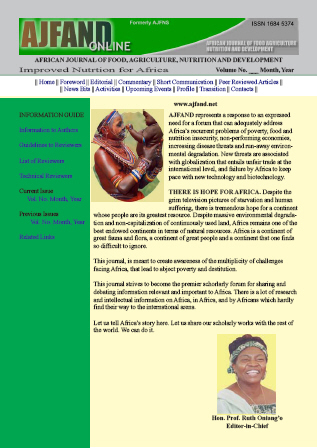
|
African Journal of Food, Agriculture, Nutrition and Development
Rural Outreach Program
ISSN: 1684-5358
EISSN: 1684-5358
Vol. 20, No. 4, 2020, pp. 16127-16143
|
 Bioline Code: nd20060
Bioline Code: nd20060
Full paper language: English
Document type: Research Article
Document available free of charge
|
|
|
African Journal of Food, Agriculture, Nutrition and Development, Vol. 20, No. 4, 2020, pp. 16127-16143
| en |
NUTRIENT CONTENT OF ON-FARM FORMULATED NILE TILAPIA ( Oreochromis niloticus  ) FEEDS: IMPLICATIONS FOR THE AQUACULTURE INDUSTRY IN KENYA ) FEEDS: IMPLICATIONS FOR THE AQUACULTURE INDUSTRY IN KENYA
Muteti, MK; Lokuruka, MNI & Yasindi, AW
Abstract
Due to the high costs and the unavailability of good quality fish feeds in Kenya, farmers
have opted to use cheaper, locally available on-farm formulated feeds. In spite of this,
farmers continue to incur losses probably due to poor nutritive quality of these on-farm
feeds. Furthermore, literature on the proximate composition and appropriateness of on-farm
formulated feeds for raising farmed fish in Kenya is scanty. Motivated by these
reasons, this study sought to investigate the proximate composition of on-farm
formulated Nile tilapia feeds and selected commercial fish feeds used in Bomet, Kericho
and Nakuru Counties of the Rift Valley Region of Kenya and compared the proximate
composition with the official nutrient composition of fish feeds. The method of feed
formulation used was also investigated using semi-structured questionnaires. The study
also estimated the weight of fish harvested at the end of a production cycle. The results
revealed a significant difference between the sampled feeds’ moisture, crude protein and
mineral contents and the legislated nutrient levels of the commercial feeds commonly
used in the counties. There was also a significant difference between the crude protein
content of feeds in the three counties (P < 0.05). More than 50% of respondent farmers
in the three counties used Pearson Square Method for fish feed formulation, while the
rest used the trial and error method. The mean weight of fish during harvest was
311.5±155.8 g with fish from Kericho County weighing significantly lower than those
from Nakuru and Bomet Counties (P < 0.05). Most of the on-farm formulated feeds from
the three counties do not meet the recommended nutrient requirements for raising Nile
Tilapia. This may be contributing to the observed low weights of the fish harvested, the
low fish production and the apparent stagnation of the aquaculture sub-sector in Kenya.
The study recommends the formulation of good quality fish feeds through the use of
proper methods and appropriate ingredients. This could be achieved through monthly
farmers’ trainings on best aquaculture practices.
Keywords
On- farm formulated feeds; fish feed quality; Nutrients; Nile tilapia; Kenya
|
| |
© Copyright 2020 - African Journal of Food, Agriculture, Nutrition and Development
Alternative site location: http://www.ajfand.net/
|
|
